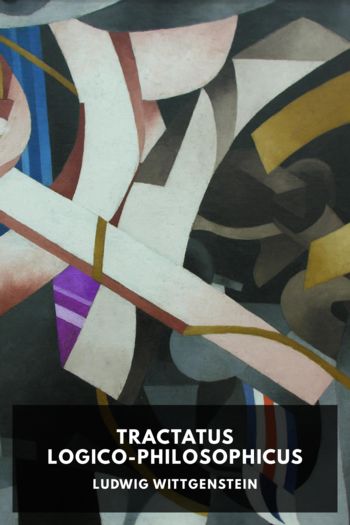Tractatus Logico-Philosophicus - Ludwig Wittgenstein (top 10 ebook reader TXT) 📗

- Author: Ludwig Wittgenstein
Book online «Tractatus Logico-Philosophicus - Ludwig Wittgenstein (top 10 ebook reader TXT) 📗». Author Ludwig Wittgenstein
The theory of classes is altogether superfluous in mathematics.
This is connected with the fact that the generality which we need in mathematics is not the accidental one.
6.1The propositions of logic are tautologies.
6.11The propositions of logic therefore say nothing. (They are the analytical propositions.)
6.111Theories which make a proposition of logic appear substantial are always false. One could e.g. believe that the words “true” and “false” signify two properties among other properties, and then it would appear as a remarkable fact that every proposition possesses one of these properties. This now by no means appears self-evident, no more so than the proposition “All roses are either yellow or red” would seem even if it were true. Indeed our proposition now gets quite the character of a proposition of natural science and this is a certain symptom of its being falsely understood.
6.112The correct explanation of logical propositions must give them a peculiar position among all propositions.
6.113It is the characteristic mark of logical propositions that one can perceive in the symbol alone that they are true; and this fact contains in itself the whole philosophy of logic. And so also it is one of the most important facts that the truth or falsehood of non-logical propositions can not be recognized from the propositions alone.
6.12The fact that the propositions of logic are tautologies shows the formal—logical—properties of language, of the world.
That its constituent parts connected together in this way give a tautology characterizes the logic of its constituent parts.
In order that propositions connected together in a definite way may give a tautology they must have definite properties of structure. That they give a tautology when so connected shows therefore that they possess these properties of structure.
6.1201That e.g. the propositions “p” and “~p” in the connection “~(p.~p)” give a tautology shows that they contradict one another. That the propositions “p⊃q”, “p” and “q” connected together in the form “(p⊃q).(p):⊃:(q)” give a tautology shows that q follows from p and p⊃q. That “(x).fx:⊃:fa” is a tautology shows that fa follows from (x).fx, etc. etc.
6.1202It is clear that we could have used for this purpose contradictions instead of tautologies.
6.1203In order to recognize a tautology as such, we can, in cases in which no sign of generality occurs in the tautology, make use of the following intuitive method: I write instead of “p”, “q”, “r”, etc., “TpF”, “TqF”, “TrF”, etc. The truth-combinations I express by brackets, e.g.:
and the coordination of the truth or falsity of the whole proposition with the truth-combinations of the truth-arguments by lines in the following way:
This sign, for example, would therefore present the proposition p⊃q. Now I will proceed to inquire whether such a proposition as ~(p.~p) (The Law of Contradiction) is a tautology. The form “~ξ” is written in our notation
the form “ξ.η” thus:—
Hence the proposition ~(p.~q) runs thus:—
If here we put “p” instead of “q” and examine the combination of the outermost T and F with the innermost, it is seen that the truth of the whole proposition is coordinated with all the truth-combinations of its argument, its falsity with none of the truth-combinations.
6.121The propositions of logic demonstrate the logical properties of propositions, by combining them into propositions which say nothing.
This method could be called a zero-method. In a logical proposition propositions are brought into equilibrium with one another, and the state of equilibrium then shows how these propositions must be logically constructed.
6.122Whence it follows that we can get on without logical propositions, for we can recognize in an adequate notation the formal properties of the propositions by mere inspection.
6.1221If for example two propositions “p” and “q” give a tautology in the connection “p⊃q”, then it is clear that q follows from p.
E.g. that “q” follows from “p⊃q.p” we see from these two propositions themselves, but we can also show it by combining them to “q” follows from “p⊃q.p:⊃:q” and then showing that this is a tautology.
6.1222This throws light on the question why logical propositions can no more be empirically confirmed than they can be empirically refuted. Not only must a proposition of logic be incapable of being contradicted by any possible experience, but it must also be incapable of being confirmed by any such.
6.1223It now becomes clear why we often feel as though “logical truths” must be “postulated” by us. We can in fact postulate them in so far as we can postulate an adequate notation.
6.1224It also becomes clear why logic has been called the theory of forms and of inference.
6.123It is clear that the laws of logic cannot themselves obey further logical laws.
(There is not, as Russell supposed, for every “type” a special law of contradiction; but one is sufficient, since it is not applied to itself.)
6.1231The mark of logical propositions is not their general





Comments (0)